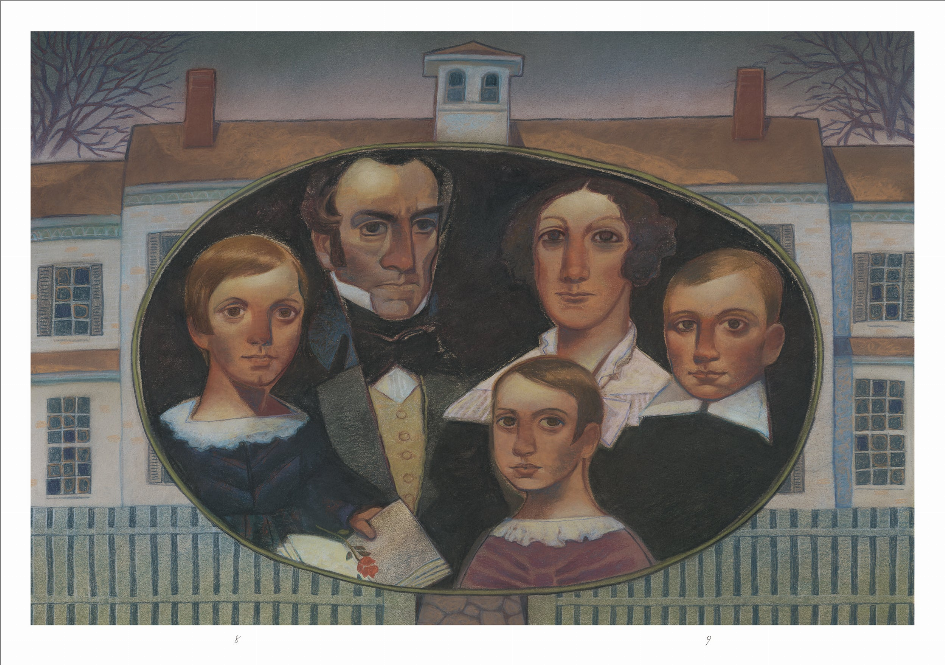Description
Acclaimed writer Jane Yolen employs 15 sonnets, accompanied by brief biographical notes, to tell of the reclusive life and literary innovations of 19th-century American poet Emily Dickinson.
A sonnet sequence encapsulates the biography of one of America's most intriguing poets, Emily Dickinson. Loosely following Shakespearean and the occasional Petrarchan rhyme schemes, Yolen cleverly adopts personae of important figures in Dickinson's lifeincluding the voice of the poet herselfto reveal key elements of her biography. Aiming to "tell the truth" of Dickinson's life, Yolen effectively conveys the importance of family and nature, privacy, imagination and independence in Dickinson's famously unconventional existence. Averse to traditional schooling and organized religion, the poet reveals: "I learned the spelling of the bee,/The mathematics of the rose//I found more in the books of air;/My higher education won/From every bird found flying there." Yolen also offers a sympathetic portrait of Dickinson's reclusiveness"What need for me an open door/When in myself is so much more?"and idiosyncratic dress: "sometimes a white dress is only that, / It keeps the daily choices few." Accompanying the sonnets, Kelley's dark and chunky pastels underscore Dickinson's interior life. Occasionally, attempts to echo Dickinson's poetic surprises yield muddled results, as in "Hedges," where Yolen's Dickinson depicts her shrubs as "My soldiers, steady in a row, / Their helmets verdigrised by God,/Wearing epaulettes of crow." Overall, though, these poems, illustrations and substantial notes combine well to lend a rounded portrait of this American poet every young reader needs to discover.
Vicky Smith, Kirkus Reviews , November 2012
Yolen joins the throng of writers who have celebrated Emily Dickinson with this slim set of 15 sonnets devoted to facets of her life. The selections are constructed in various voices, each identified by the poem's title. In the first five pieces, Emily speaks of the family's brick house, her close relationship with her sister Vinnie, her schooling, her variance with her family's religious beliefs, and the companionship of her dog. The strict poetry pattern, page after page, becomes repetitiously rhythmic, and a few images have a puzzling fit within their poem. Some terms and phrases echo Dickinson's poems, and each sonnet is complemented by an endnote of related biographical information. The other speakers, Vinnie, an anonymous critic, author and mentor Thomas Wentworth Higginson, and Yolen herself along with later pieces by Emily Dickinson, go on to tell of her always dressing in white, her life as a recluse, and her work. Niece Mattie reveals a playful side in the poet's relationship with her brother's children. Kelley's somber, full-page paintings reflect Emily's references to the grim mien of the Dickinson parents and also offer a sense of the poet's contemplative life. Yolen's personal tribute is framed in two concluding poems, a sonnet on Emily Dickinson's still-standing house, and a brief parting poem. The choice of topics and spare lines, along with the added notes, efficiently convey a full sense of Dickinson as person and poet.
Margaret Bush, School Library Journal , January 2013
Poet Jane Yolen has long loved the poems written by Emily Dickinson, and she feels a closeness to Emily even though they live "two towns and slightly more than fifty years apart." In this unique book, Jane Yolen tells Emily's story from six points of view. We hear the "voices" of Emily, her sister Vinnie, her niece Mattie, her friend Thomas, an unknown critic, and Jane Yolen herself. The tale begins with Emily telling us how "cold as winter's core" her mother was and how close Emily was to her older brother and her younger sister. Both her brother, who "strove so hard my life to save / From drowning in that icy wave," and her sister seemed to recognize Emily's sensitive personlity. From Vinnie we hear about how Emily scribbles poetry on "chance slips" of paper. In these poems, "Her perceptions all drawn line by line," Emily reveals little parts of herself, but she does not choose to share them with the world. To Emily's niece Mattie, Emily is "Like Queen Mab who endless reigns, / Upon the hillside." She is a magical being who is neither an adult nor a child. Emily is the one who spends time with Mattie and the other children, who gives them treats and takes their side. Vinnie is the one who, when Emily is gone, finds Emily's poems and decides that they must be saved and "published for the ages." Adults and children alike will be moved by the power and beauty in these poems. Jane Yolen captures how Emily felt about her own life, and how others felt about her and her incredible gift. We see how Emily chose to live a quiet life without a husband or children, and how much she was loved and admired by those who knew her. We also appreciate why, to so many, her words are a gift, "a fine embrace." At the back of the book Jane Yolen provides her readers with further information about Emily Dickinson's life, her work, and her legacy.
Marya Jansen-Gruber, Through the Looking Glass , November 2012




